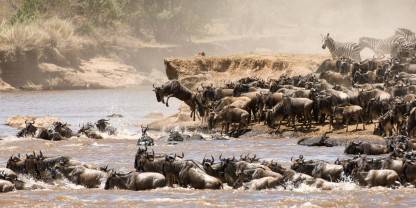- January: Excellent
- February: Excellent
- March: Fair
- April: Fair
- May: Fair
- June: Excellent
- July: Excellent
- August: Excellent
- September: Excellent
- October: Excellent
- November: Good
- December: Good
- Excellent
- Good
- Fair
- Poor
Wildlife viewing is good throughout the year in Serengeti National Park, but certain areas are better at specific times. Most people want to see the and the predator action that goes with it. The good thing is that you can witness different stages of the migration in Serengeti from around January to October, so most of the year. The bad news is that the movement of the wildebeest depends on the rain and the exact timings are unpredictable.
Around January to February is a fantastic time to be in the Ndutu area for the wildebeest calving. June and July is the best time to be in the Western Corridor, and during August and September the migration is in the north where you might be able to see the famous Mara River crossings. Beware though that the crowds follow this calendar, so for an uncrowded experience you should stay away from the migration.
3,908 Serengeti Safaris
-
Best Time
- January to February and June to October (Different areas are best at different times)
-
High Season
- July to March (It is high season at different times in different areas, but Seronera is usually crowded)
-
Low Season
- April and May (Lower rates may apply)
-
Best Weather
- June to October (Little to no rainfall)
-
Worst Weather
- March and April (Peak of the Wet season)
June to October Dry Season
- Wildebeest migration is best seen in June and July in the Western Corridor and in August and September in the north of the park
- Animals are easier to spot since they gather around waterholes and rivers and the vegetation is less thick
- It is mostly sunny and there is very little rain
- There are few mosquitoes and the chance of contracting malaria is minimal
- The Seronera area gets crowded
- The Mara River area is busy when there are wildebeest river crossings (August and September)
- Mornings and nights get cold; warm clothing is recommended
November to May Wet Season
- January to February is the time to see the wildebeest calving and is an excellent time to see predator action
- The scenery is lush
- April and May are low season, so it's usually less crowded and rates might be lower
- Although wildlife is easier to spot in the Dry season, the Serengeti offers good wildlife viewing throughout the year
- Migratory birds are present from November to April and bird watching is at its best
- Except for March and April, rains are mostly short afternoon storms and will seldom interfere with your trip
- March to April is the peak of the Wet season
Wildlife Photos
Best Time To Go by Major Park
- Excellent
- Good
- Fair
- Poor
-
Gombe National Park
- January: Fair
- February: Fair
- March: Fair
- April: Poor
- May: Fair
- June: Good
- July: Excellent
- August: Excellent
- September: Excellent
- October: Excellent
- November: Good
- December: Fair
-
Katavi National Park
- January: Fair
- February: Fair
- March: Poor
- April: Poor
- May: Poor
- June: Good
- July: Excellent
- August: Excellent
- September: Excellent
- October: Excellent
- November: Fair
- December: Fair
-
Lake Manyara National Park
- January: Good
- February: Good
- March: Fair
- April: Fair
- May: Good
- June: Excellent
- July: Excellent
- August: Excellent
- September: Excellent
- October: Excellent
- November: Good
- December: Good
-
Ngorongoro Crater
- January: Excellent
- February: Excellent
- March: Good
- April: Good
- May: Excellent
- June: Excellent
- July: Excellent
- August: Excellent
- September: Excellent
- October: Excellent
- November: Excellent
- December: Excellent
-
Nyerere National Park
- January: Fair
- February: Fair
- March: Poor
- April: Poor
- May: Fair
- June: Excellent
- July: Excellent
- August: Excellent
- September: Excellent
- October: Excellent
- November: Good
- December: Good
-
Ruaha National Park
- January: Fair
- February: Fair
- March: Poor
- April: Poor
- May: Fair
- June: Excellent
- July: Excellent
- August: Excellent
- September: Excellent
- October: Excellent
- November: Good
- December: Good
-
Serengeti National Park
- January: Excellent
- February: Excellent
- March: Fair
- April: Fair
- May: Fair
- June: Excellent
- July: Excellent
- August: Excellent
- September: Excellent
- October: Excellent
- November: Good
- December: Good
-
Tarangire National Park
- January: Fair
- February: Fair
- March: Fair
- April: Fair
- May: Fair
- June: Good
- July: Excellent
- August: Excellent
- September: Excellent
- October: Excellent
- November: Excellent
- December: Good



